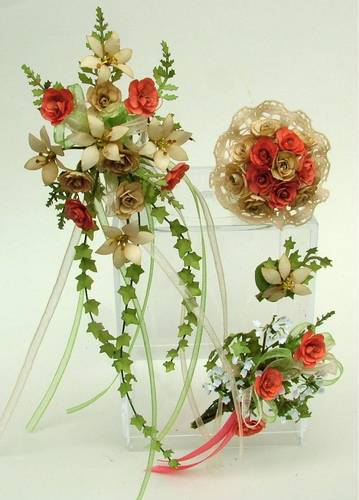History of Wedding Flowers...
By Kathryn Gray of Templewood Miniatures (formerly Fine Flowers In Miniature)
Flowers and herbs have been used at wedding or joining ceremonies since the time of the ancient Greeks. Flowers, plants and herbs were used initially as a crown that the bride would wear and were considered to promote fertility and a gift of nature.
The garland was considered to be a symbol of love and happiness and was worn by both the bride and groom.
Bridal Bouquets
The bridal bouquet and garland was originally made of herbs and bulbs of garlic, it was said to have magical powers to ward of any evil spirits that may harm the couples future and also the herbs, which were eaten by the couple, were said to promote fertility.
The herbs used had different meanings and properties just as flowers had in Victorian times. For example ivy in a wedding bouquet assures good luck, lilies signify purity, apple blossom, better things to come and the herb myrtle is supposed to bring good luck.
During the early part of the 20th century the small posies went out of fashion and cascade arrangements came into popularity, even during recessions brides preferred larger bouquets, however nowadays there is not one type of preference, cascade, posies and hand held flowers all have there place.
In a modern miniature wedding scene or wedding room box any type of arrangement would be excellent – but for an accurate historical perspective the following would apply:
Tudor – hand held herb posyVictorian – early part, long cascade arrangement – latter part, small hand held posies.
Edwardian – cascade of flowers
1940s & 50s – time of austerity – simple posies or single flowers
Kissing Knots...
Posies...
The small hand held posies regain popularity in the Victorian times when Queen Victoria carried a ‘Tussie Mussie’ containing herbs, during her marriage to prince Albert – brides during this era often carried bouquets containing just one type of flower which expressed the sentiments she felt for her new husband – roses were seen to expressing her love, lilies were again for purity and red poppies were for a time popular as they expressed the pleasure her husband had brought into her life.
Although many of the flowers still used in bouquets have traditional meaning nowadays the flowers are used to complement the personal tastes and colour schemes of the wedding.
